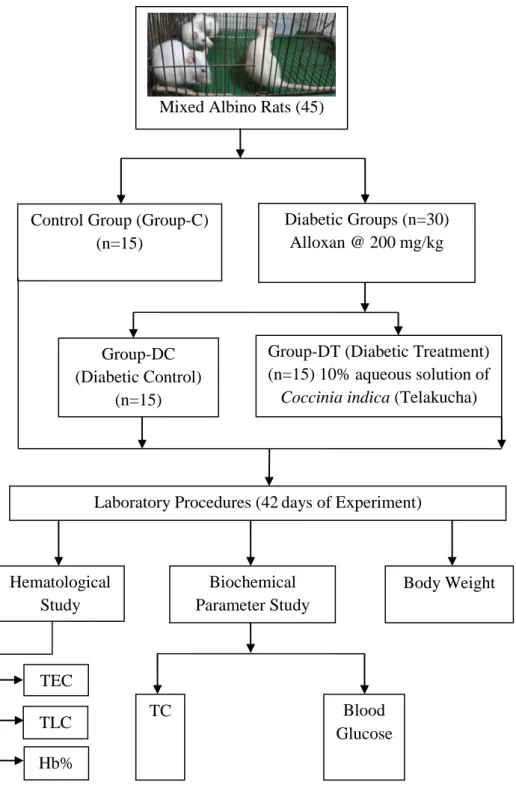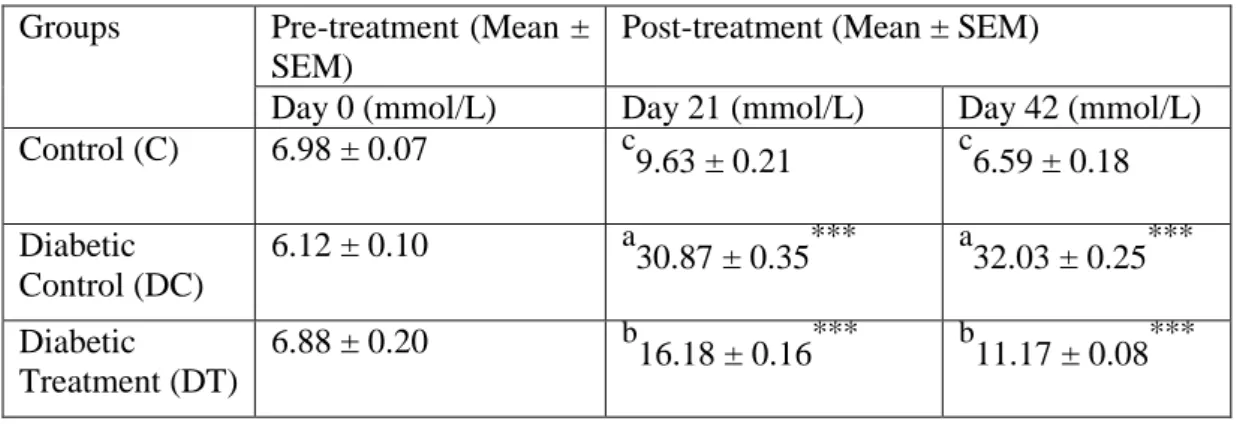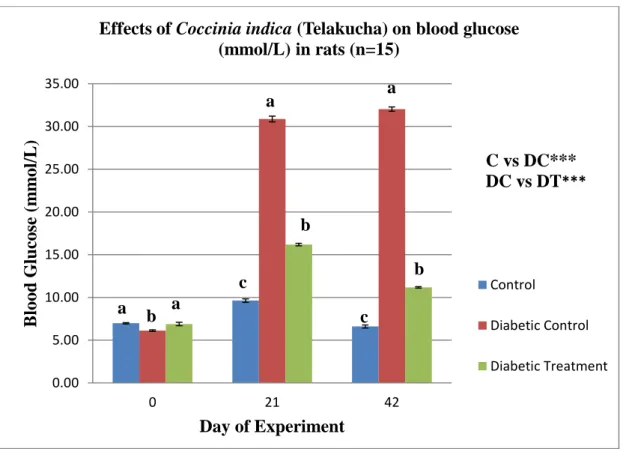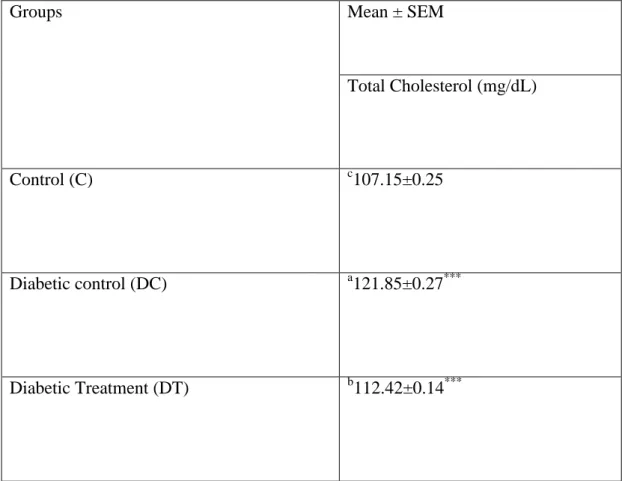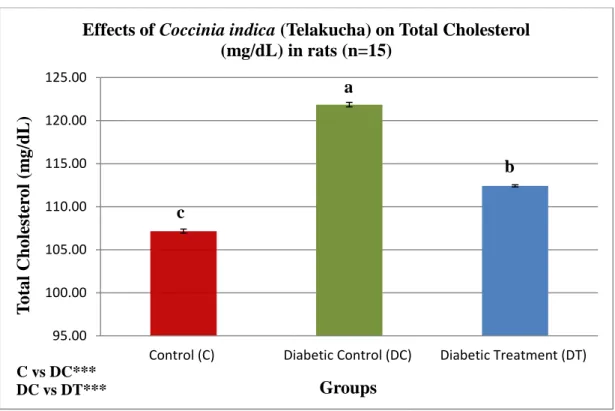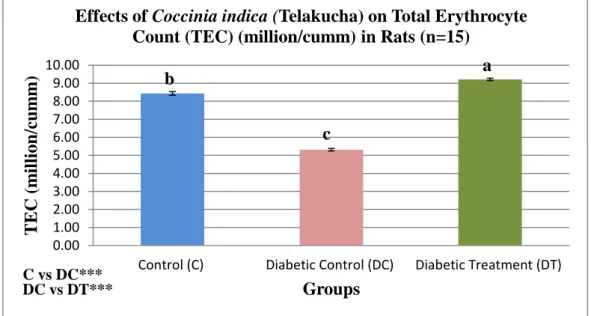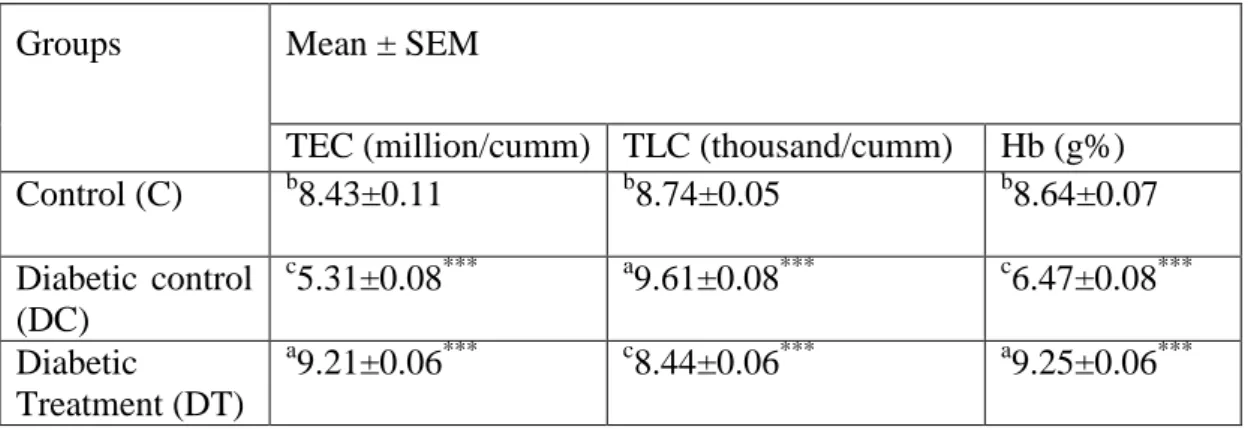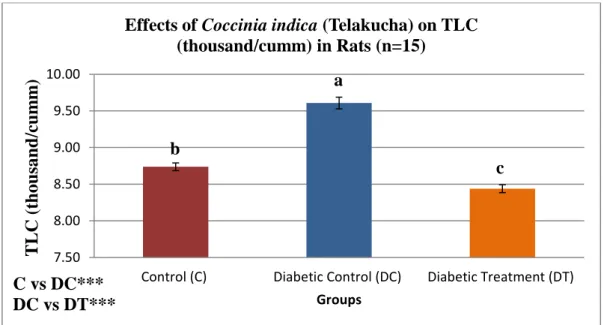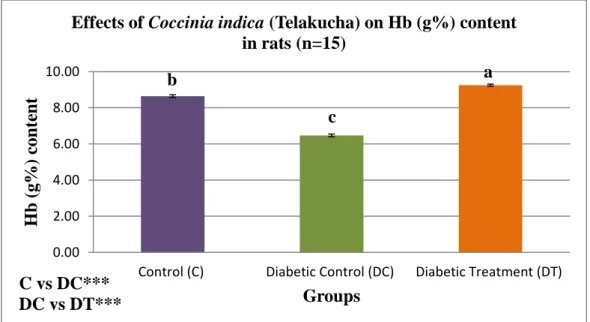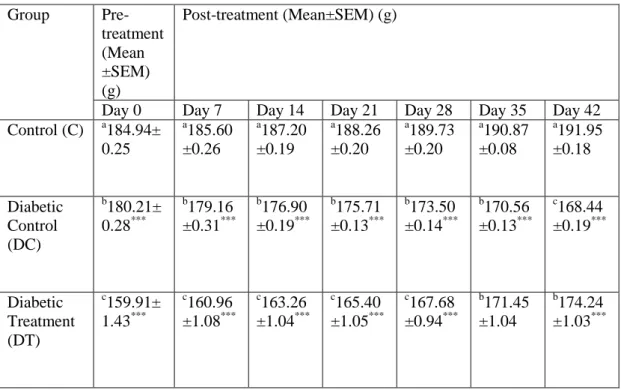HEMATOBIOCHEMICAL EFFECTS OF TELAKUCHA (Coccinia indica) IN ALLOXAN INDUCED DIABETIC RATS
SUJAN KUMAR SARKAR
DEPARTMENT OF ANATOMY, HISTOLOGY & PHYSIOLOGY SHER-E-BANGLA AGRICULTURAL UNIVERSITY
SHER-E-BANGLA NAGAR, DHAKA-1207
JUNE, 2020
HEMATOBIOCHEMICAL EFFECTS OF TELAKUCHA (Coccinia indica) IN ALLOXAN INDUCED DIABETIC RATS
BY
SUJAN KUMAR SARKAR REGISTRATION NUMBER: 12-05036
A Thesis
Submitted to the Department of Anatomy, Histology & Physiology, Sher-e-Bangla Agricultural University, Dhaka-1207, in partial fulfillment
of the requirements for the degree of
MASTER OF SCIENCE (MS) IN ANATOMY DEPARTMENT OF ANATOMY, HISTOLOGY &
PHYSIOLOGY
SEMESTER: JAN-JUN/2020
APPROVED BY
Dr. Mohammad Saiful Islam Supervisor
Chairman & Associate Professor Department of Anatomy, Histology &
Physiology
Sher-e-Bangla Agricultural University Sher-e-Bangla Nagar, Dhaka-1207,
Bangladesh
Dr. Mohammad Mejbah Uddin Co-Supervisor
Professor
Department of Anatomy & Histology Chittagong Veterinary and Animal
Sciences University Khulshi, Chattogram 4225,
Bangladesh.
Dr. Mohammad Saiful Islam
III
Department of Anatomy, Histology & Physiology Sher-e-Bangla Agricultural University
Sher-e-Bangla Nagar, Dhaka-1207 MEMO NO: SAU/
CERTIFICATE
this is to certify that the thesis entitled “HEMATOBIOCHEMICAL EFFECTS OF TELAKUCHA (Coccinia indica) IN ALLOXAN INDUCED DIABETIC RATS” submitted to the department of ANATOMY, HISTOLOGY & pHYSIOLOGY, Sher-e-Bangla Agricultural University, Sher-e-bangla nagar, Dhaka-1207, in partial fulfillment of the requirements for the degree of Master of Science (MS) in ANATOMY, embodies the result of a piece of bona fide research work carried out by SUJAN KUMAR SARKAR, Registration No.12- 05036, under my supervision and guidance. No part of the thesis has been submitted for any other degree or diploma.
I further certify that any help or source of information, received during the course of this investigation has been duly acknowledged.
Dated: June, 2020
Place: Dhaka, Bangladesh
Dr. Mohammad Saiful Islam Supervisor
Chairman & Associate Professor Department of Anatomy, Histology &
Physiology
Sher-e-Bangla Agricultural University Sher-e-Bangla Nagar, Dhaka-1207,
Bangladesh
ACKNOWLEDGEMENT
All praises goes to the almighty God, who has created the universe and enabled the author to complete this piece of research work and preparation of this thesis successfully for the degree of Masters of Science (MS) in Anatomy under the Department of Anatomy, Histology & Physiology.
The author with a sense of respect expresses his heartfelt gratitude to his Supervisor Dr. Mohammad Saiful Islam, Associate Professor, Department of Anatomy, Histology &
Physioogy, Sher-e-Bangla Agricultural University, Dhaka-1207, for his untiring and painstaking guidance, invaluable suggestions, continuous supervision, timely instructions, inspirations and constructive criticism throughout the tenure of research work.
Heartfelt gratitude and profound respect for his Co-Supervisor Dr. Mohammad Mejbah Uddin , Professor, Department of Anatomy & Histology, Faculty of Veterinary Medicine, Chittagong Veterinary & Animal Sciences University, for his co-operation, constructive criticism, and valuable suggestions for the modification and improvement of the research work.
The author is deeply grateful to Dr. Md. Abdul Masum, Associate Professor, Department of Anatomy, Histology &
Physioogy, Sher-e-Bangla Agricultural University, Dhaka-1207, for his kind help & guidance with advices and co-operation in the completion of the study.
The author is deeply grateful to Dr. Md. Mosharaf Hossain,
V
Physioogy, Sher-e-Bangla Agricultural University, Dhaka-1207, for his valuable suggestions and kind support in the fulfillment of the study.
The author is also grateful to all the staffs of the Department of Anatomy, Histology & Physiology, Sher-e-Bangla Agricultural University, Dhaka-1207, for their co-operation.
The author takes the opportunity to express his indebtedness and profound respect to his parents for their love, blessings, prayers, sacrifices, moral support and encouragement for his study which can never be forgotten.
The author sincerely acknowledges the Sher-e-Bangla agricultural University Authority for providing laboratory supports that enable him to complete the research work more smoothly.
The Author
LIST OF CONTENTS
ACKNOWLEDGEMENT ... IV LIST OF CONTENTS ... VI LIST OF PLATES ... VIII LIST OF TABLES ... IX LIST OF FIGURES ... X ACRONYMS AND ABBREVIATIONS ... XI ABSTRACT ... XV
1 INTRODUCTION ... 1
2 REVIEW OF LITERATURE ... 4
3 MATERIALS AND METHODS ... 8
3.1 Selection of Research Site ... 8
3.2 Experimental Rats ... 8
3.2.1 Collection of Rats ... 8
3.2.2 Acclimatization of Rats... 8
3.3 Supplied Diet for Experimental Rats ... 8
3.4 Experimental Design ... 10
3.5 Induction of Diabetes in Rats ... 11
3.6 Collection, Preparation & Preservation of Telakucha Leaf Extract (TLE) ... 12
3.7 Determination of Blood Glucose... 12
3.8 Determination of Total Cholesterol... 14
3.9 Collection of Blood for Hematological Tests ... 14
3.10 Determination of Hematological Parameters ... 16
3.10.1 Determination of Total Erythrocyte Count (TEC) ... 16
3.10.2 Determination of Total Leukocyte Count (TLC) ... 17
VII
3.11 Determination of Body weight ... 19
3.12 Statistical Analysis ... 20
4 RESULT ... 21
4.1 Effects of Telakucha on Blood Glucose Level... 21
4.2 Effects of Telakucha on Serum Total Cholesterol ... 22
4.3 Effects of Telakucha on Hematological Parameters ... 24
4.3.1 Effects of Telakucha on Total Erythrocyte Count (TEC) ... 24
4.3.2 Effects of Telakucha on Total Leukocyte Count (TLC) ... 26
4.3.3 Effects of Telakucha on Hemoglobin Content... 27
4.4 Effects of Telakucha on Body Weight ... 28
5 DISCUSSION ... 30
5.1 Effects of Telakucha on Blood Glucose Level... 30
5.2 Effects of Telakucha on Serum Total Cholesterol ... 31
5.3 Effects of Telakucha on Hematological Parameters ... 31
5.3.1 Effects of Telakucha on Total Erythrocyte Count (TEC) ... 31
5.3.2 Effects of Telakucha on Total Leukocyte Count (TLC) ... 32
5.3.3 Effects of Telakucha on Hemoglobin Content... 32
5.4 Effects of Telakucha on Body Weight ... 32
6 SUMMARY AND CONCLUSION ... 33
REFERENCES ... 34
LIST OF PLATES
Plate 1 Housing of Rats... 9
Plate 2 Feeding and Watering of Rats... 9
Plate 3 Preparation of Alloxan Solution ... 11
Plate 4 Intraperitoneal Administration of Alloxan... 11
Plate 5 Preparation of Telakucha Leaf Extract ... 12
Plate 6 Determination of Blood Glucose ... 13
Plate 7 Determination of Blood Total Cholesterol ... 13
Plate 8 Sacrificing Animals ... 15
Plate 9 Vacuum Tube for Blood Collection ... 15
Plate 10 Materials for Hematological Test ... 16
Plate 11 Determination of Total Erythrocyte Count (TEC) ... 17
Plate 12 Determination of Total Leukocyte Count (TLC) ... 18
Plate 13 Estimation of Hemoglobin ... 18
Plate 14 Weighing of Rats ... 19
IX
LIST OF TABLES
Table 1 Effects of Telakucha on Blood Glucose (mmol/L) ... 21
Table 2 Effects of Telakucha on Total Cholesterol (mg/dL) ... 23
Table 3 Effects of Telakucha on Hematological Parameters ... 25
Table 4 Effects of Telakucha on Body Weight (g) ... 28
LIST OF FIGURES
Figure 1 Layout of the Experimental Design ... 10
Figure 2 Effects of Telakucha on Blood Glucose (mmol/L) ... 22
Figure 3 Effects of Telakucha on Total Cholesterol (mg/dL) ... 24
Figure 4 Effects of Telakucha on TEC (million/cumm) ... 25
Figure 5 Effects of Telakucha on TLC (thousand/cumm) ... 26
Figure 6: Effects of Telakucha on Hb (g%) content ... 27
Figure 7 Effects of Telakucha on Body Weight (g) ... 29
XI
ACRONYMS AND ABBREVIATIONS
ACh : Acetylcholine
ADP : Adenosine Di Phosphate
ALP : Alkaline Phosphatase
ALX : Alloxan
ANOVA : Analysis of Variance
ATP : Adenosine Tri Phosphate
b. wt. : Body Weight
BCSIR : Bangladesh Council of Scientific and Industrial Research
cc : Cubic centimeter
CD : Cluster of Differentiation
CFV : Cresyl Fast Violet
CHOD-PAP : Cholesterol Oxidase Phenol 4-Aminoantipyrine Peroxidase
CLEt Coccinia indica leaf extract
cm : Centimeter
cumm : Cubic Millimeter
CPK : Creatine Phosphokinase
dL : Deciliter
DM : Diabetes Mellitus
DNA : Deoxyribonucleic acid
ED : Experimental Diabetes
EDRF : Endothelium-Derived Relaxing Factor EPR : Electron Paramagnetic Resonance
g : Gram
g% : Gram Percent
GLUT2 : Glucose Transporter 2
G-6-P : Glucose-6 phosphate
GMP : Guanosine Monophosphate
GSH : Glutathion
H2O
2 : Hydrogen peroxide
Hb : Hemoglobin
HCl : Hydrochloric Acid
HDL : High Density Lipoprotein
Hg : Mercury
ICDDR,B : International Centre for Diarrhoeal Diseases Research and Rehabilitation, Bangladesh
IDDM : Insulin Dependent Diabetes Mellitus IDF : International Diabetes Federation
K3EDTA : Tripotassium Ethylenediaminetetraacetic Acid
XIII
LCF : Lipid Clearing Factor
LDL : Low Density Lipoprotein
LDH : Lactate Dehydrogenase
LFB : Luxol Fast Blue
LPO : Lipid Peroxidation
LPL : Lipoprotein lipase
mg : Milligram
MIG : Middle Income Group
MLD : Multiple Low Doses
mmol/ L : Milimole Per Liter
NAC : N-acetylcysteine
NAFLD : Non-Alcoholic Fatty Liver Disease NASH : Nonalcoholic Steatohepatitis NFkB : Nuclear Transcription Factor kB
NIDDM : Non-Insulin Dependent Diabetes Mellitus
PPBS : Post-Prandial Blood Sugar
ROS : Reactive Oxygen Species
SEM : Standard Error of Mean
SGOT : Serum Glutamic Oxaloacetic Transaminase SGPT : Serum Glutamic Pyruvic Transaminase
SOD : Superoxide Dismutase
SPSS : Statistical Package for the Social Sciences / Statistical Product and Service Solutions
STZ : Streptozotocin
TBARS : Thiobarbituric Acid Reactive Substance
TC : Total Cholesterol
TEC : Total Erythrocyte Count
TG : Triglyceride
TLC : Total Leukocyte Count
TLE Telakucha (Coccinia indica) Leaf Extract VLDL : Very Low Density Lipoprotein
vs : Versus
WBC : White Blood Cell
WHO : World Health Organization
Δ : Delta
μL : Microliter
@ : at the rate of
® : Registered Sign
XV
HEMATOBIOCHEMICAL EFFECTS OF TELAKUCHA (Coccinia indica) IN ALLOXAN INDUCED DIABETIC RATS
ABSTRACT
The study was undertaken to investigate the effects of Telakucha (Coccinia indica) on blood glucose, serum total cholesterol, hematological parameters and body weight on alloxan induced diabetic rats. Forty five rats were divided into 3 equal groups: Control (C), Diabetic Control (DC) and Diabetic Treatment (DT). DT group was treated with 10% aqueous extract of Telakucha 500 mg/kg body weight. Telakucha extract reduced the amount of blood glucose significantly (P<0.001) in the group DT compared to DC from 32.03 ± 0.25 to 11.17 ± 0.08 mmol/L. Total cholesterol (TC) was decreased significantly (P<0.001) in group DT compared to group DC from 121.85±0.27 to 112.42±0.14 mg/dL. In hematological study, DT group showed significant (P<0.001) increase of erythrocytes count & Hb (g%) content and decrease (P<0.001) of total leukocyte count after 42 days of treatment in contrast with DC group. The body weight was also increased significantly (P<0.001) in DT group.
Based on present research it can be concluded that Telakucha can be used in the treatment of diabetes as an alternative to commercial medicine.
Keywords: Hematobiochemical, Hematological, Antihypercholesterolemic, Antidiabetic, Coccinia indica, Telakucha
1 INTRODUCTION
Inadequate production of insulin by the pancreas or the inability of the body to respond to the insulin can develop a metabolic disorder that is Diabetes Mellitus (DM). DM mostly affects humans as a major health problem which may lead to death.
It is the most common endocrine disorder characterized by hyperglycemia and responsible for long term complications like retinopathy, nephropathy, neuropathy and macro vascular disease (Manjula & Ragavan; 2007). According to WHO, Diabetes mellitus (DM) contributes significantly to the high mortality from non- communicable diseases worldwide.
Even though Diabetes mellitus occurs all over the world, it is exceedingly common (especially type 2) in the more developed countries. However, the highest prevalence is expected to happen in Asia and Africa by 2030 (Wild et. al. 2004). Globally, 463 million people have diabetes and this number is projected to reach 578 million by 2030, and 700 million by 2045 (IDF, 2019). In Bangladesh, the number of detected diabetic patients reached 8.4 million along with the undetected diabetic patients almost 4.7 million (IDF, 2019).
Chronic hyperglycemia during DM creates oxidative stress, altering the redox balance of the body that gives raises of reactive oxygen species (Prasath & Subramanian, 2013). Oxidative stress causes tissue and organ damage by increasing oxidation of carbohydrate, protein, lipid and DNA (Yachamaneni et. al., 2016). Oxidative stress is more likely to be happened in the liver, due to DM (Tolman et. al., 2007). Different disorders related with glycogen & lipid metabolism are formed in liver by DM (Sanchez et. al., 2000). Similarly, the oxidative stress also causes the diabetic kidney complications (Brownlee, 2001). Moreover, excessive hyperglycemic effects damage the β cells of pancreas, although the β cells can tolerate the oxidative stress most (Robertson et. al., 2004).
People with diabetes have high blood glucose level due to lack of insulin (Ponnusamy et. al., 2011). Among the cases in which body can not produce sufficient insulin or perfectly use it, 90-95% cases are found to be type 2 diabetes or non-insulin- dependent diabetes mellitus (Li et. al., 2004).
2
To induce experimental diabetes (ED), streptozotocin (STZ) and alloxan are mostly used in laboratory animals. Streptozotocin (STZ) is a methylating agent for DNA (Bennett et. al., 1981) that destroys pancreatic beta cells, inducing permanent diabetes. Alloxan is a toxic agent for pancreas beta cells; its proposed mechanism for diabetes induction includes: sulfhydryl group attack, chelate action, enzyme and metabolic modifications; membrane transport changes on electrolytes (Carrol et. al., 1994) plus increased lipoperoxidation (Soto et. al., 1994).
Insulin and various oral anti-diabetic agents such as sulfonylureas, biguanides and glinides are recently being used as available medications for diabetes. Most of the drugs have series of adverse effects; so, it is one of the crucial areas of investigation to find out new safer and more effective anti-hyperglycemic agents (Saxena &
Vikram, 2004).
For the introduction of new anti-diabetic therapeutics, conventional medicines from readily available medicinal plants provide a great possibility (Jung et. al., 2006). Most of the plants show anti-diabetic effects due to presence of glycosides, alkaloids, terpenoids, flavonoids, carotenoids, etc. (Malviya et. al., 2010).
Coccinia indica, known in Bangladesh as 'Telakucha', has been shown to possess hypoglycemic activity in both laboratory animals (Chopra & Bose, 1925;
Brahmachari & Augusti, 1963; Mukherjee et. al., 1972) and human subjects (Khan et al., 1980). A study says, oral administration of dried extract of Coccinia indica at 500 mg/kg, p.o. for 6 weeks markedly increased insulin concentration. Both in experimental animals and diabetic human, the plant extract proved to have beneficial hypoglycemic effect possibly by insulin secreting action or by influencing the enzymes engaged in glucose metabolism (Singh, 2011).
C. indica leaves have the insulin stimulatory effect from the β cell of diabetic rats. It possesses hypoglycemic, anti-diabetic, hypolipidemic, hepatoprotective, larvvicidal, Anti-inflammatory, analgesic and antipyretic activities. Various phytoconstituents are found in Coccinia indica like cephalandrol, tritriacontane, lupeol, b-sitosterol, cephalandrine A, cephalandrine B, stigma-7-en-3-one, taraxerone and taraxerol.
Terpenoids are bleived to be responsible for antidiabetic activity (Deokate &
Khadabadi, 2011).
The aim of this study is to present the protective effects of Coccinia indica
„Telakucha‟ extract against the experimental diabetic complications in rats.
Considering the economic resource constrains and availability of this herbal product (Coccinia indica ‘Telakucha‟) the objectives of this study are:
To evaluate the efficacy of (Coccinia indica ‘Telakucha‟) on
Blood glucose level
Serum total cholesterol level
Hematological parameters and
Body weight in experimentally diabetic rats
4
2 REVIEW OF LITERATURE
Diabetes mellitus is a chronic metabolic disorder in human. There are many herbal products proved to be having good anti-diabetic potential. Attempts have been made to reflect some of those works that are related with the present study and the efforts made by numerous researchers are compiled here.
Chopra et. al. (1958) reported that, C. indica or Telakucha is available in Bangladesh in large quantities and native people use it as the medication of diabetes mellitus in Bangladesh and India. Throughout the Indian subcontinent, the plant has also been widely used in Ayurvedic and Unani practice.
Mukherjee et. al. (1972) reported that the aqueous and ethanolic extract of Coccinia indica leaves have the antihyperglycemic activity.
Singh et. al. (1985) utilized dried extract of whole plant and reported the insulin like activities of the ingredients present in the extract that correct the increased enzymes G-6-P (ase), LDH in glycolytic pathway and compensate the LPL action in lypolytic pathway in conjunction with the control of hyperglycemia in diabetes.
Hossain et. al. (1992); Kuriyan et. al. (2008) indicated, although Coccinia indica has a wide range of use in conventional medicine, it has lack of enough clinical trials in methodical way of study to assess the therapeutic values. In some human experiments, active ingredients found in Coccinia indica extract have shown control over the higher blood glucose level in diabetic patients along with minimizing the increased level of glucose-6-phosphatase & lactase dehydrogenase enzymes in glycolytic pathway and regaining the action of lipoprotein lipase in lipolytic pathway.
Shibib et. al. (1993) administered ethanol extract of Coccinia indica leaves in streptozotocin induced male diabetic rats at an oral dose of 200 mg/kg body weight.
The treatment caused in the lowering of blood glucose level by depressing the hepatic gluconeogenic enzymes glucose-6-phosphatase and fructose-1,6-bisphosphatase and by elevating both the red-cell and hepatic glucose-6-phosphate dehydrogenase (G6PDH) activities that contributes in the shunt pathway for glucose oxidation.
Kamble et. al. (1998) stated that the Coccinia indica is a perennial creeper, has been traditionally used in herbal medicine and it has the insulin mimetic property.
Venkateswaran & Pari (2002) showed the insulin stimulatory effects of Coccinia indica leaves extract from existing β- cells in diabetic rats. Oral administration of 200mg/kg of Coccinia indica leaves extract (CLEt) for 45 days reduced blood glucose, glycosylated haemeglobin and increased total haemoglobin and plasma insulin in diabetic animals. Normal animals exhibited hypoglycemia in the similar way after administration of Coccinia indica leaves extract (CLEt). CLEt was also able to improve the altered carbohydrate metabolic enzymes in liver and it was more effective than glibenclamide in diabetic rats.
Pari & Venkateswaran (2003) investigated the effect of Coccinia indica on blood glucose, plasma insulin, cholesterol, triglycerides, free fatty acids and phospholipids and fatty acid composition of total lipids in liver, kidney and brain of normal and streptozotocin (STZ) diabetic rats. Oral administration of the ethanolic extract of Coccinia indica leaves (200 mg/kg body weight, CLEt) for 45 days to diabetic rats decreased the concentrations of blood glucose, lipids and fatty acids, viz., palmitic, stearic, and oleic acid whereas linolenic and arachidonic acid and plasma insulin were elevated. They suggested that Coccinia indica exhibits hypoglycaemic and hypolipidaemic effects in STZ induced diabetic rats. It also prevents the fatty acid changes produced during diabetes.
Venkateswaran & Pari (2003) experimented Coccinia indica leaf extract (CLEt) (200 mg/kg body weight orally) for 45 days and reported an indicatory reducing effect on plasma thiobarbituric acid reactive substances, hydroperoxides, vitamin E and ceruloplasmin. The extract also acts as antioxidant by elevating the plasma vitamin C and reducing the glutathione markedly. The Coccinia indica leaf extract (CLEt) at 200 mg/kg body weight shown more efficacy than glibenclamide.
Rao et. al. (2003) observed the hepatoprotective activity of ethanolic extract of Coccinia indica fruits, in CCL4 induced hepatotoxic rats by both enzymatic and histopatholgical assessment of liver.
Manjula & Ragavan (2007) reported the hypolipidemic effect of Coccinia indica aqueous leaf extract in alloxan induced diabetic rats. The results of this study showed that a continuous administration of Coccinia indica extract for 21 days prevents the
6
Vinothkumar et. al. (2009) administered Coccinia indica leaf extract orally at 250 mg/kg body weight for 10 days in CCl4 induced hepatotoxic albino rats and reported the regenerative activity of it. Animals showed reduced ALT, AST& ALP in blood and absence of necrosis, regenerating hepatocyte and vasculoprotective activity in histopathological examination of liver.
Balaraman et. al. (2010) evaluated antihyperglycemic and hypolipidemic effects of ethanol extract of aerial parts of Coccinia indica in STZ induced diabetes in Sprague–
Dawley rats. The rats were treated for 14 days with the dose of 100 or 200 mg/kg b.w.
p.o.. They measured the blood glucose level and body weight in 5 days interval.
Administration Coccinia indica extract in diabetic rats caused significant antihyperglycemic and hypolipidemic effects (p< 0.001). The extracts were also found to be significantly effective (p< 0.001; p< 0.05) on recovery of altered biochemical parameters and decreased body weight in treated animals.
Gunjam et. al. (2010) found antihyperglycemic activity of Coccinia indica after continuous administration of its fruits extract at dose of 200 mg/kg for 14 days.
Kumar et. al. (2010) investigated the hepatoprotective activity of Coccinia indica leaves extract at dose 400mg/kg body weight and compared with a known hepatoprotective drug; silamyrin at 125 mg/kg body weight. After induction of hepatotoxicity with carbon tetrachloride, the rats were treated with silymarin and diethyl ether extract of Coccinia indica and animals showed decreased hepatic damages, minor necrosis with no indicative pathological manifestation.
Bhattacharya et. al. (2011) reported the “in vitro” and “in vivo” anticancer activity of the Coccinia grandis(indica) plant extract against Ehrlich Ascites Carcinoma (EAC) cell on mice. Ethanol extracts and vinblastine (reference drug) are injected intra- peritoneally. After treatment for nine days mice were weighed and sacrificed on the 10th day. Viable (live) and nonviable (dead) cell counting, intra-peritoneal fluid volume, packed cell volume, haemoglobin concentration, RBC counting, WBC counting and survival time (days) were determined. Ethanol extract produced significant reduction in viable cell and increase in the number of non-viable cell count. They also stated that the extracts have the significant protective role in haematological parameters.
Munasinghe et. al. (2011) evaluated the hypoglycemic effect of Coccinia indica in a double-blind clinical trial on 61 healthsome human being and found the blood sugar level in experimental group markedly lower than that of control group.
Patel et. al. (2012) reported that the substances found in Coccinia indica extract show antihyperglycemic activity by exerting insulin-secreting effect or by controlling the enzymatic process involved in the metabolic pathway of glucose.
Shibib et. al. (2012) reported that the Coccinia indica leaves extract can reduce blood glucose along with the reduction of free fatty acid in blood and showed anti-ureogenic effects by decreasing the activity of major urea cycle enzyme hepatic arginase after oral administration in rat.
Junaid et. al. (2019) investigated the antihyperglycemic effect of Coccinia indica and stated that the plant has some potentiality to increase plasma insulin, hepatic hexokinase and glycogen synthetase activity and to decrease the liver gluconeogenic enymes along with the regeneration of β-cell.
8
3 MATERIALS AND METHODS
This study was conducted in the Department of Anatomy, Histology & Physiology, Sher-e-Bangla Agricultural University, Dhaka to evaluate the efficacy of Coccinia indica (Telakucha) leaf extract on diabetic induced mixed albino rats. The following procedures were followed for conducting this study.
3.1 Selection of Research Site
The laboratory animal house of the Department of Anatomy, Histology & Physiology was selected for the research work. The research was carried out during the period from November, 2019 to March, 2020.
3.2 Experimental Rats 3.2.1 Collection of Rats
Total forty five (45) healthy mixed albino rats were collected from Pharmacology laboratory of Jahangirnagar University, Savar, Dhaka.
3.2.2 Acclimatization of Rats
Before starting the experiment, all the rats were acclimatized to the new environmental condition for a period of one week. Rats were housed in compartmentalized rectangular metallic cages wrapped with wire mesh (Plate 1). Rats were kept in separate cages arranged in rows according to group. Each cage was labeled for identification of different groups. The cages were kept in well ventilated room at 28 ± 20C and a relative humidity of 70-80% with natural day and light. The experimental laboratory was cleaned and washed with disinfectants at a regular interval. Cages were cleaned regularly and proper hygienic and sanitary measures were also taken during the experimental period. Feces were removed regularly.
3.3 Supplied Diet for Experimental Rats
Rats pellet were collected from ICDDR, B, Mohakhali, Dhaka. Pellet was supplied @ 15g/ rat / day for entire period of the experiment and drinking water was provided ad- libitum during the experimental period (Plate 2).
Plate 1 Housing of Rats
Plate 2 Feeding and Watering of Rats
10 3.4 Experimental Design
A total forty five (45) mixed albino rats of two months old were allocated for this experiment. The rats were randomly divided into three (3) groups and each group was replicated 3 times with 5 rats in each replicate (Figure 1).
Mixed Albino Rats (45)
Control Group (Group-C) (n=15)
Diabetic Groups (n=30) Alloxan @ 200 mg/kg
Group-DC (Diabetic Control)
(n=15)
Group-DT (Diabetic Treatment) (n=15) 10% aqueous solution of Coccinia indica (Telakucha)
Laboratory Procedures (42days of Experiment)
Hematological Study
Biochemical Parameter Study
Body Weight
TEC
TC Blood
Glucose TLC
Hb%
Figure 1 Layout of the Experimental Design
3.5 Induction of Diabetes in Rats Procedure
A bottle of 25 g alloxan (SIGMA- ALDRICH Company, UK) was gifted by Dr.
Shafiqul Islam, Professor of Pharmacology, Bangladesh Agricultural University. 200 mg alloxan was added into 5mL normal saline (Norsol®) followed by mixing with the help of mortar and pastel and vortex machine to make the solution homogenous (Plate 3). The solution was then kept in a container and used to induce diabetes in 2 groups of rats (DC and DT) at the rate of 200 mg/ kg body weight intraperitoneally (Plate 4) as a single dose (Federiuk et. al., 2004).
Plate 3 Preparation of Alloxan Solution
Plate 4 Intraperitoneal Administration of Alloxan
12
3.6 Collection, Preparation & Preservation of Telakucha Leaf Extract (TLE) Fresh, clean and delicate telakucha (Coccinia indica) leaves were collected from the tangled vegetation in non-cultivated area of Sher-e-Bangla Agricultural University campus. The leaves were dried by using freeze dry method and powdered with the help of mortar and pastel. 100 g of leaf powder was mixed with 1 L boiling distilled water and stirred for 2 hour and the volume was readjusted by topping up with sufficient distilled water. Thus, a 10% aqueous solution of telakucha (Coccinia indica) leaf extract was prepared. It was kept overnight at 4°C and then filtered and the filtrate was collected for further use (Plate 5). The telakucha (Coccinia indica) leaf extract was used as the crude leaf extract to study the anti-diabetic effect in alloxan induced diabetic rats. During treatment, group DT was treated with telakucha (Coccinia indica) leaf extract at the rate of 500 mg/ kg/ day for 42 days treatment period (Singh, 2011)
Plate 5 Preparation of Telakucha Leaf Extract
3.7 Determination of Blood Glucose
Blood samples were collected from tail vein on 0, 21st and 42nd day of experiment and blood glucose was determined by using glucose oxidase-peroxidase reactive strips and a glucometer (UNI-CHECK®,Visgeneer, Taiwan) (Plate 6).
Procedure:
The tail was disinfected by rubbing a cotton ball soaked in Hexisol® Solution. Small amount of blood was drawn from tail vein of the rats by venipuncture with help of
insulin syringe and needle (Plate 6). At the same time the glucometer was started with a single press. Before using the test strip new coding chip was inserted by the side of the monitor. After the monitor showed the code number the strip was inserted into the designated slot. A drop of blood was then dropped on the test zone of the strip. The result was shown on monitor within 5 seconds of dropping the blood on the zone of the strip in mmol/ L (Plate 6).
Plate 6 Determination of Blood Glucose
14 3.8 Determination of Total Cholesterol
Blood samples were collected from tail vein on 42nd day of experiment and blood cholesterol was determined by using a blood testing meter(EasyMate® GCU, Bioptik Technology Inc., Taiwan) (Plate 7).
Procedure:
The tail was disinfected by rubbing a cotton ball soaked in Hexisol® Solution. Small amount of blood was drawn from tail vein of the rats by venipuncture with help of insulin syringe and needle (Plate 7). At the same time the EasyMate® GCU blood testing meter was started with a single press. Before using the test strip new coding chip was inserted by the side of the monitor. After the monitor showed the code number the strip was inserted into the designated slot. A drop of blood was then dropped on the test zone of the strip. The result was shown on monitor within 150 seconds of dropping the blood on the zone of the strip in mg/dL (Plate 7).
3.9 Collection of Blood for Hematological Tests Procedure:
On the 42nd day of experiment, blood samples were collected by sacrificing the rats (Plate 8). The rats were euthanized after the administration of Xylazine HCl® @ 12mg/kg in combination with Ketamine HCl® @ 75mg/kg body weight intramuscularly (Burke, 1999). Then they were transferred onto a sterile tray. After that the thoracic and abdominal cavities were opened surgically with the help of scalpel, scissors and forceps. Blood was collected directly from the heart with the sterile syringe and needle. About 1mL of blood from the syringe was taken in the vacuum tube containing anticoagulant (K3EDTA) for hematological studies (Plate 9).
Plate 8 Sacrificing Animals
16
3.10 Determination of Hematological Parameters
Hematolgical parameters including total erythrocyte, total leukocyte and hemoglobin content were determined by following some specific procedures with the help of required materials (Plate 10).
Plate 10 Materials for Hematological Test
3.10.1 Determination of Total Erythrocyte Count (TEC) Procedure:
A clean dry counting chamber was placed under microscope and the central fine ruled area was focused by low power objective (10X). Well mixed anticoagulated blood was drawn by the red blood cell pipette up to 0.5 marks. Excess blood above the mark and the sticky blood around the pipette were removed with the help of cotton.
Hayem‟s solution was drawn by the blood containing pipette exactly 101 mark. Then the contents of the pipette were mixed thoroughly by 8 knot motion for 1-2 minutes.
After proper mixing at least 2-3 drops of fluid were expelled from the pipette and any next drop was placed on the counting chamber and covered by coverslip and wait for 3 minutes for settle down of RBC (Plate 11). The cells were counted from four corners square and one central square each of which containing 16 small squares. The cells were observed by high power objective (45X). The number of RBC was calculated as follows:
Number of RBC=No. of red cell counted X 200 X 50 and the result was expressed in million/cummof blood (Dacie and Lewis, 1958; D‟Armour et. al., 1965).
Plate 11 Determination of Total Erythrocyte Count (TEC)
3.10.2 Determination of Total Leukocyte Count (TLC) Procedure:
A clean dry counting chamber was placed under microscope and the central fine ruled area was focused by low power objective (10X). Well mixed anticoagulated blood was drawn by the white blood cell pipette up to 0.5 marks. Excess blood above the mark and the sticky blood around the pipette were removed with the help of cotton.
HCl solution was drawn by the blood containing pipette exactly 11 mark. Then the contents of the pipette were mixed thoroughly by 8 knot motion for 1-2 minutes. After proper mixing at least 2-3 drops of fluid were expelled from the pipette and any next drop was placed on the counting chamber and covered by coverslip and wait for 3 minutes for settle down of WBC (Plate 12). The cells were counted from four corners squares. The cells were observed by low power objective (10X). The number of WBC was calculated as follows: Number of WBC=No. of white cells counted X 20 X 2.5 and the result was expressed in thousand/cumm of blood (Dacie and Lewis, 1958;
D‟Armour et. al., 1965).
18
Plate 12 Determination of Total Leukocyte Count (TLC)
Plate 13 Estimation of Hemoglobin
3.10.3 Estimation of Hemoglobin Procedure:
N/10 HCl was taken in the diluting tube up to its 2 gm% mark. Well mixed anticoagulated blood was drawn by the Sahli pipette up to 20 µl mark. Immediately, the blood of the pipette was transferred into the diluting tube containing N/10 HCl and the pipette was rinsed for 2-3 times. The content was mixed thoroughly and left for five minutes in the comparator. After 5 minutes distilled water was added drop by drop and mixed with the help of stirrer. The mixing was continued until and unless the color in the diluting tube matched with the color of comparator. After matching the tube was removed and the result was recorded from the graduated scale (Plate 13).
The result was expressed in g% or in gm/100 cc of blood (Sood, 1999).
3.11 Determination of Body weight Procedure:
Body weights of the rats of all groups were recorded before treatment (on day 0) and during treatment period i.e. 7th, 14th, 21st, 28th, 35th and 42nd day by using weighing machine (Plate 14).
Plate 14 Weighing of Rats
20 3.12 Statistical Analysis
All data were expressed as mean ± SEM (n=15) and differences among the groups of animals were compared using one-way ANOVA with post-hoc LSD and Duncan‟s test. Statistical significance was set at P < 0.05. Statistical analysis was performed using SPSS software version 25 (SPSS Inc., Chicago, IL, USA).
4 RESULT
The study was carried out to evaluate the effects of Coccinia indica (Telakucha) on (i) blood glucose (ii) serum total cholesterol (TC); (iii) hematological parameters i.e.
TEC, TLC, Hb; and (iv) body weight. The research work was conducted in 3 groups (each group consisting of 15 rats) of rats following dietary supplementation of standard rats pellet and Coccinia indica (Telakucha). The results of the experiment are presented under the following sections:
4.1 Effects of Telakucha on Blood Glucose Level
The effects of Coccinia indica (Telakucha) on blood glucose level to control diabetes in rats are presented in Figure 2.
The results indicated that, pretreatment with alloxan (@200 mg/kg) induced hyperglycemia in group DC and DT, and this hyperglycemia were reduced by treating them with Coccinia indica (Telakucha) in DT (Diabetic Treatment) group (Table 1).
In my study, 10% aqueous solution of Coccinia indica (Telakucha) leaf extract was found to significantly (P<0.001) reduce blood glucose levels to 16.18±0.16 and 11.12±0.08 mmol/L in 21st and 42nd day respectively comparing with the DC group (Table 1).
Table 1 Effects of Telakucha on Blood Glucose (mmol/L) Groups Pre-treatment (Mean ±
SEM)
Post-treatment (Mean ± SEM)
Day 0 (mmol/L) Day 21 (mmol/L) Day 42 (mmol/L) Control (C) 6.98 ± 0.07 c9.63 ± 0.21 c6.59 ± 0.18 Diabetic
Control (DC)
6.12 ± 0.10 a30.87 ± 0.35*** a32.03 ± 0.25***
Diabetic
Treatment (DT)
6.88 ± 0.20 b16.18 ± 0.16*** b11.17 ± 0.08***
Data are shown as mean±SEM of n = 15 samples per group. Values with different superscripts within a column differ significantly (P<0.05); * = Significant at 5 percent level (P<0.05); ** = Significant at 1 percent level (P<0.01); *** = Significant at 0.1
22
Figure 2 Effects of Telakucha on Blood Glucose (mmol/L)
Here, C= Control, DC= Diabetic Control, DT= Diabetic Treatment. Values represent as mean ± SEM (n=15 samples per group); a, b, ab, c
Values in the different column with different superscripts letters are significantly different (P<0.05); * = Significant at 5 percent level (P<0.05); ** = Significant at 1 percent level (P<0.01); *** = Significant at 0.1 percent level (P<0.001) [ANOVA-DMRT].
4.2 Effects of Telakucha on Serum Total Cholesterol
The effects of Coccinia indica (Telakucha) on serum total cholesterol (TC) are shown in Figure 3. At the end of the experimental period, it was found that, total cholesterol level was raised significantly (P<0.001) on diabetes induced rats (group DC) in comparison to control (C) group (Table 2). Total cholesterol value decreased
0.00 5.00 10.00 15.00 20.00 25.00 30.00 35.00
0 21 42
Blood Glucose (mmol/L)
Day of Experiment
Effects of Coccinia indica (Telakucha) on blood glucose (mmol/L) in rats (n=15)
Control
Diabetic Control Diabetic Treatment
C vs DC***
DC vs DT***
a b a
c c
a a
b b
significantly (P<0.001) in Diabetic Treatment (DT) group by treating them with Coccinia indica (Telakucha) in alloxan induced diabetic rats (Table 2).
Table 2 Effects of Telakucha on Total Cholesterol (mg/dL)
Groups Mean ± SEM
Total Cholesterol (mg/dL)
Control (C) c107.15±0.25
Diabetic control (DC) a121.85±0.27***
Diabetic Treatment (DT) b112.42±0.14***
Data are shown as mean±SEM of n = 15 samples per group. a, b, ab, c, d
Values with different superscripts within a column differ significantly (P<0.05); *= Significant at 5 percent level (P<0.05); ** = Significant at 1 percent level (P<0.01); *** = Significant at 0.1 percent level (P<0.001).
24
Figure 3 Effects of Telakucha on Total Cholesterol (mg/dL)
Results are expressed as mean±SEM (n=15 samples per group); a, b, c Values in the different column with different superscripts letters are significantly different (P<0.05); * = Significant at 5 percent level (P<0.05); ** = Significant at 1 percent level (P<0.01); *** = Significant at 0.1 percent level (P<0.001) [ANOVA-DMRT].
Here, C= Control, DC= Diabetic Control, DT= Diabetic Treatment.
4.3 Effects of Telakucha on Hematological Parameters
4.3.1 Effects of Telakucha on Total Erythrocyte Count (TEC)
Effects of Coccinia indica (Telakucha) on TEC of diabetic rats are shown in Figure 4.
After induction of diabetes by alloxan TEC values were significantly (P<0.001) reduced in DC group to 5.31±0.08 million/cumm compared to control (C) group. On the other hand, TEC values were significantly (P<0.001) increased upto 9.21±0.06 million/cumm in DT group compared to DC group (Table 3).
95.00 100.00 105.00 110.00 115.00 120.00 125.00
Control (C) Diabetic Control (DC) Diabetic Treatment (DT)
Total Cholesterol (mg/dL)
Groups
Effects of Coccinia indica (Telakucha) on Total Cholesterol (mg/dL) in rats (n=15)
C vs DC***
DC vs DT***
c
a
b
Table 3 Effects of Telakucha on Hematological Parameters
Groups Mean ± SEM
TEC (million/cumm) TLC (thousand/cumm) Hb (g%)
Control (C) b8.43±0.11 b8.74±0.05 b8.64±0.07
Diabetic control (DC)
c5.31±0.08*** a9.61±0.08*** c6.47±0.08***
Diabetic
Treatment (DT)
a9.21±0.06*** c8.44±0.06*** a9.25±0.06***
Data are shown as mean±SEM of n = 15 samples per group. Values with different superscripts within a column differ significantly (P<0.05); * = Significant at 5 percent level (P<0.05); ** = Significant at 1 percent level (P<0.01); *** = Significant at 0.1 percent level (P<0.001).
Figure 4 Effects of Telakucha on TEC (million/cumm)
Results are expressed as mean ± SEM (n=15 samples per group); a, b, ab, c
Values in the
0.00 1.00 2.00 3.00 4.00 5.00 6.00 7.00 8.00 9.00 10.00
Control (C) Diabetic Control (DC) Diabetic Treatment (DT)
TEC (million/cumm)
Groups
Effects of Coccinia indica (Telakucha) on Total Erythrocyte Count (TEC) (million/cumm) in Rats (n=15)
C vs DC***
DC vs DT***
b
c
a
26
level (P<0.01); *** = Significant at 0.1 percent level (P<0.001) [ANOVA-DMRT].
Here, C= Control, DC= Diabetic Control, DT= Diabetic Treatment.
4.3.2 Effects of Telakucha on Total Leukocyte Count (TLC)
Figure 5 represent the effects of Coccinia indica (Telakucha) on total leukocyte count (TLC) in alloxan induced diabetic rats. The results indicated that after alloxan administration TLC was significantly (P<0.001) increased in DC group compared to control group. After getting treatment, there was a significant (P<0.001) reduction of white blood cells in treated group DT compared to the DC group (Table 3).
Figure 5 Effects of Telakucha on TLC (thousand/cumm)
Results are expressed as mean ± SEM (n=15 samples per group); a, b, c Values in the different column with different superscripts letters are significantly different (P<0.05); * = Significant at 5 percent level (P<0.05); ** = Significant at 1 percent level (P<0.01); *** = Significant at 0.1 percent level (P<0.001) [ANOVA-DMRT].
Here, C= Control, DC= Diabetic Control, DT= Diabetic Treatment.
7.50 8.00 8.50 9.00 9.50 10.00
Control (C) Diabetic Control (DC) Diabetic Treatment (DT)
TLC (thousand/cumm)
Groups
Effects of Coccinia indica (Telakucha) on TLC (thousand/cumm) in Rats (n=15)
b
a
c
C vs DC***
DC vs DT***
4.3.3 Effects of Telakucha on Hemoglobin Content
Figure 6 shows the effect of Coccinia indica (Telakucha) on hemoglobin (g%) content in control and diabetic rats. In diabetic control (DC) group hemoglobin content was significantly (P<0.001) reduced to 6.47±0.08 g% after alloxan administration compared to control (C) group rats. After treating them with Coccinia indica (Telakucha), there was significant increase in hemoglobin content to 9.25±0.06 g% in diabetic treatment (DT) group (Table 3)
Figure 6: Effects of Telakucha on Hb (g%) content
Results are expressed as mean ± SEM (n=15 samples per group); a, b, c Values in the different column with different superscripts letters are significantly different (P<0.05); * = Significant at 5 percent level (P<0.05); ** = Significant at 1 percent level (P<0.01); *** = Significant at 0.1 percent level (P<0.001) [ANOVA-DMRT].
Here, C= Control, DC= Diabetic Control, DT= Diabetic Treatment.
0.00 2.00 4.00 6.00 8.00 10.00
Control (C) Diabetic Control (DC) Diabetic Treatment (DT)
Hb (g%) content
Groups
Effects of Coccinia indica (Telakucha) on Hb (g%) content in rats (n=15)
C vs DC***
DC vs DT***
b
c
a
28 4.4 Effects of Telakucha on Body Weight
Figure 7 shows the effects of administration of Coccinia indica (Telakucha) on body weight of alloxan induced diabetic rats. After induction of diabetes in rats, there was a significant (P<0.001) reduction in body weight of diabetic control (DC) group rats to 168.44±0.19 g (Table 4). After treating with Coccinia indica (Telakucha) a significant (P<0.001) increase in body weight was observed to 174.24±1.03g in diabetic treatment (DT) group compared to diabetic control (DC) group rats (Table 4).
Table 4 Effects of Telakucha on Body Weight (g)
Group Pre-
treatment (Mean
±SEM) (g)
Post-treatment (Mean±SEM) (g)
Day 0 Day 7 Day 14 Day 21 Day 28 Day 35 Day 42 Control (C) a184.94±
0.25
a185.60
±0.26
a187.20
±0.19
a188.26
±0.20
a189.73
±0.20
a190.87
±0.08
a191.95
±0.18
Diabetic Control (DC)
b180.21±
0.28***
b179.16
±0.31***
b176.90
±0.19***
b175.71
±0.13***
b173.50
±0.14***
b170.56
±0.13***
c168.44
±0.19***
Diabetic Treatment (DT)
c159.91±
1.43***
c160.96
±1.08***
c163.26
±1.04***
c165.40
±1.05***
c167.68
±0.94***
b171.45
±1.04
b174.24
±1.03***
Data are shown as mean±SEM of n = 15 samples per group. Values with different superscripts within a column differ significantly (P<0.05); * = Significant at 5 percent level (P<0.05); ** = Significant at 1 percent level (P<0.01); *** = Significant at 0.1 percent level (P<0.001)
Figure 7 Effects of Telakucha on Body Weight (g)
Results are expressed as mean ± SEM (n=15 samples per group); a, b, c Values in the different column with different superscripts letters are significantly different (P<0.05); * = Significant at 5 percent level (P<0.05); ** = Significant at 1 percent level (P<0.01); *** = Significant at 0.1 percent level (P<0.001) [ANOVA-DMRT].
Here, C= Control, DC= Diabetic Control, DT= Diabetic Treatment.
0.00 50.00 100.00 150.00 200.00 250.00
0 7 14 21 28 35 42
Body Weight (g)
Day of Experiment
Effects of Coccinia indica (Telakucha) on Body Weight (g) in Rats (n=15)
Control (C)
Diabetic Control (DC) Diabetic Treatment (DT)
a b c
a b c
a b c
a b c
a b c
a b b
a c b
C vs DC***
DC vs DT***
30
5 DISCUSSION
In this experiment, attempts were made to study the effects of Coccinia indica (Telakucha) on (i) blood glucose; (ii) total serum cholesterol; iii) hematological parameters i.e. TEC, TLC and Hb; and (iv) body weight in experimentally alloxan induced diabetic rats. To perform this experiment, total 45 rats were randomly divided into 3 groups each containing 15 rats. Among them one group was kept as control (C) and in the rest 2 groups diabetes was induced. Among the 2 groups one group was kept as diabetic control (DC) and rest 1 was treated with Coccinia indica (Telakucha) for 42 days experimental period and all the above mentioned parameters were investigated as per schedule.
5.1 Effects of Telakucha on Blood Glucose Level
After alloxan administration, diabetes was induced which can be confirmed by observing the increased blood glucose level in DC group to 30.87 ± 0.35 and 32.03 ± 0.25 mmol/L in 21st and 42ndday respectively ( Table 1). The hyperglycemic effect of alloxan is may be damaging the β cells of pancreas that interfered the synthesis of insulin which might be responsible for the metabolism of glucose. As a result the level of blood glucose was increased (Bopanna et. al. 1997).
When treated them with Coccinia indica (Telakucha), it was indicated that telakucha reduced the blood glucose level to an extent. Coccinia indica (Telakucha) treatment significantly (P<0.001) reduced blood glucose level (Table 1) which was also similar with the findings of (Shibib et. al. 1993).
Treatment with oral administration of Coccinia indica (Telakucha) extract to diabetic rats significantly (P<0.05) reduced the level of blood glucose to near normal levels (Venkateswaran & Pari, 2002). The mechanism of the anti-diabetic properties of the extract is not well known.
The plant extract showed to exert beneficial hypoglycemic effect in experimental animals and human diabetic subject possibly through an insulin secreting effect or through influence of enzymes involved in glucose metabolism (Singh, 2011).
The active ingredients found in Coccinia indica extract have shown control over the higher blood glucose level in diabetic patients along with minimizing the increased level of glucose-6-phosphatase & lactase dehydrogenase enzymes in glycolytic
pathway and regaining the action of lipoprotein lipase in lipolytic pathway (Hossain et. al. 1992; Kamble et. al. 1998; Kuriyan et. al. 2008).
Shibib et. al. (1993) suggested that the Coccinia indica leaf extract lowered blood glucose level by depressing the hepatic gluconeogenic enzymes glucose-6- phosphatase and fructose-1,6-bisphosphatase and by elevating both the red-cell and hepatic glucose-6-phosphate dehydrogenase (G6PDH) activities that contributes in the shunt pathway for glucose oxidation.
5.2 Effects of Telakucha on Serum Total Cholesterol
In alloxan induced diabetic rats the content of total cholesterol increased significantly (P<0.001) in diabetic treatment group (Table 2) which is similar with (Balaraman et.
al., 2010). Alloxan causes the production of excess fatty acid in plasma that enhances the liver conversion of home fatty acids into phospholipids and cholesterol (Rhoads et. al., 1976).
Following the treatment with Coccinia indica extract, the serum total cholesterol level was significantly reduced (P<0.001) (Table 2). This result is similar with Balaraman et. al. (2010) who found that administration of Coccinia indica extracts tend to bring the level to near normal. In diabetic rats, Coccinia indica extracts protect against the changes in fatty acid and lipid composition significantly, that may be due to increased plasma insulin and improved glycemic control (Pari & Venkateswaran, 2003).
5.3 Effects of Telakucha on Hematological Parameters
5.3.1 Effects of Telakucha on Total Erythrocyte Count (TEC)
In my study I found that, in alloxan induced diabetic rats total erythrocyte count was significantly (P<0.001) reduced compared to control rats (Table 3). On the other hand, Coccinia indica significantly increased the values in diabetic treatment group (Table 3). Similar effects of Coccinia extract were found during the experiment of „in vitro anticancer activity of Coccinia’ that showed significant protective role to increase the RBC level (Bhattacharya et. al., 2011). It is suggested from the experiment that Coccinia indica has the ability to increase TEC in alloxan induced hyperglycemic rats.
32
5.3.2 Effects of Telakucha on Total Leukocyte Count (TLC)
On 42nd day of experiment, TLC values were increased significantly (P<0.001) following administration of alloxan (Table 3). After treating them, Coccinia indica significantly (P<0.001) reduced TLC level in diabetic treatment group (Table 3).
Bhattacharya et. al. (2011) found that Coccinia extract can decrease the TLC level significantly (P<0.01) near the normal condition.
5.3.3 Effects of Telakucha on Hemoglobin Content
Alloxan induced diabetes results significant (P<0.001) decrease in blood hemoglobin content compared to control group (Table 3). After the administration of Coccinia indica extract in the treated group the values of hemoglobin were increased significantly (P<0.001) compared to diabetic control (DC) group (Table 3). The present study is partially in agreement with findings of Bhattacharya et. al. (2011) who found that Coccinia indica extract was able to increase hemoglobin significantly.
Administration of Coccinia indica extract to diabetic rats significantly increased the level of total haemoglobin (Venkateswaran & Pari, 2002).
5.4 Effects of Telakucha on Body Weight
After treating with Coccinia indica extract body weight of the treated groups were significantly (P<0.001) increased nearer to control group compared to pre-treatment period and also with groups DC (Table 4). Results of the present study partially support the findings of Venkateswaran & Pari (2002) who also observed significant increase in body weight after treatment with Coccinia indica extract in hyperglycemic animals, apparently due to its ability to reduce hyperglycemia.
This may be due to some constituents of the Coccinia indica extract which may have mimicked or stimulated the actions of growth factors hence its ability to enhance the repair and regeneration of damaged pancreatic tissue. This position is strongly supported considering the fact that significant (P<0.05) increase in growth rate was obtained for rats receiving Coccinia indica extract treatment compared with those without extract treatment (Shibib et. al., 2012).
6 SUMMARY AND CONCLUSION
The experiment was conducted in the Department of Anatomy, Histology and Physiology, Faculty of Animal Science & Veterinary Medicine, Sher-e-Bangla Agricultural University, Dhaka. Forty five (45) apparently healthy mixed albino rats were selected for the study. The rats were randomly divided into three (3) groups and each group was replicated 3 times with 5 rats in each replicate i.e. each group containing 15 rats. One group was kept as control and the other 2 groups were made hyperglycemic by injecting alloxan intraperitonially at the dose rate of 200 mg/kg b.wt. After alloxan injection, one group was kept as diabetic control and the rest one group was treated with 10% Coccinia indica (Telakucha) aqueous solution @ 500 mg/kg body weight by oral gavage for consecutive 42 days in order to evaluate the efficacy of Coccinia indica (Telakucha) on blood glucose; serum total cholesterol;
hematological parameters i.e. TEC, TLC and Hb; and body weight in rats. Body weight was measured weekly; blood glucose was measured on 0, 21st and 42nd day.
Lipid profile and hematological parameters were estimated on 42nd day of experiment.
Blood glucose levels were significantly (P<0.001) reduced in the treated groups in comparison to diabetic control (DC) group. Likewise, lipid profile values indicated a significant change after getting treatment. Total cholesterol values were significantly (P<0.001) reduced after Coccinia indica (Telakucha) therapy in the treated group compared to group DC.
On the other hand, in case of hematological parameters, TEC and Hb content were significantly (P<0.001) increased compared to diabetic control group. However, TLC values were reduced significantly (P<0.001) in the treated group rats compared to the rats of group DC. Similarly, body weight was also significantly (P<0.001) increased in the treated group in comparison to diabetic control groups. In this study, it was found that Coccinia indica (Telakucha) leaf extract has effective role in lowering blood glucose and total blood cholesterol level with regulatory effects on Hematological parameters like TEC, TLC and Hb in alloxan induced diabetic rats.
To draw a definite conclusion in this regards it demands details study including histopathology and other biochemical parameters that indicate the conditions of vital organs like pancreas, liver and kidney in the treatment of diabetic rats with the
34
REFERENCES
Adams HR. (1995). Veterinary Pharmacology and Therapeutics, 7th edition. Iowa State University. pp. 644-652
Alberti KG, Zimmet PZ. (1998). New diagnostic criteria and classification of diabetes- again? Diabetes Medicine 15(7): 535-536
Brahmachari, H. D., & Augusti, K. T. (1963). Orally effective hypoglycaemic principles from Coccinia indica Wight and Arn. Journal of Pharmacy and Pharmacology, 15, 411-412.
Bennett, R.A., Pegg, A.E. (1981). Alkylation of DNA on the rat tissues following administration of streptozotocin. Cancer Research 41(7): 2786-2790
Bopanna, K.N., Kannan, J., Sushma, G., Balaraman, R., Rathod, S.P. (1997).
Antidiabetic and antihyperlipaemic effects of neem seed kernel powder on alloxan diabetic rabbits. Indian Journal of Pharmacology 29(3): 162-167 Burke, T. (1999). Husbandry and Medicine of Rodents and Lagomorphs. Central
Veterinary Conference, Kansas City.
Brownlee, M. (2001). Biochemistry and molecular cell biology of diabetic complications. Nature, 414(6865), 813–820. https://doi.org/10.1038/414813a Balaraman, A. K., Singh, J., Dash, S., & Maity, T. K. (2010). Antihyperglycemic and
hypolipidemic effects of Melothria maderaspatana and Coccinia indica in Streptozotocin induced diabetes in rats. Saudi Pharmaceutical Journal, 18(3), 173-178. https://doi.org/10.1016/j.jsps.2010.05.009
Bhattacharya, B., Lalee, A., Mal, D. K., & Samanta, A. (2011). In-vivo and in-vitro anticancer activity of Coccinia grandis (L.) Voigt. (Family: Cucurbitaceae) on Swiss albino mice. Journal of Pharmacy Research, 4(3), 567-569.
http://jprsolutions.info
Chopra, R. N., & Bose, J. P. (1925). Cephalandra indica (Telakucha) in Diabetes. Indian Journal of Medical Research, 13(1) 11-16.
Chopra, R.N., Chopra, I.C., Handa, K.L., Kapur, L.D. (1958). Medicinal plants in diabetes. In: Gupta P ed., Indigenous drugs of India, 2nd edn, U.N. Dhar &
Sons Ltd, Calcutta, India, pp. 314–316.
